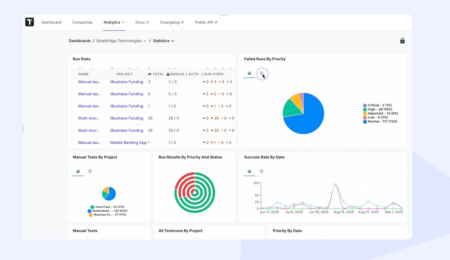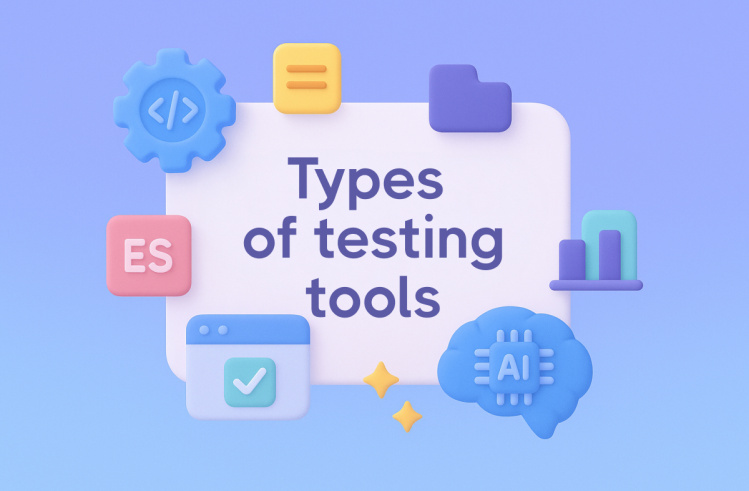The primary goal of test development is to organize the quality control process, enabling efficient tracking of product compliance with requirements.
What is test design & its role in the development process?
Test design is part of the quality assurance process, during which test case design in software testing takes place and the sequence of testing actions for a project is determined.
Hmm… Test Design is needed to:
✅ Create tests that detect critical errors
✅ Approach testing with understanding and avoid unnecessary resource expenditure
✅ Minimize the number of tests required to verify the product
The testing team decides how to maximize test coverage with minimal effort.
What Are Test Design Techniques?
Design for test is a key link between the test strategy and the specific tests used to implement the strategy. This process occurs in the context of assigning tests to specific scenarios, and its main aspects can be outlined as follows:
- It is impossible to test everything within the time and budget constraints defined in the technical specifications. A decision must be made on how deeply to dive into testing.
- The more critical the object being tested, the more intensive the checks should be. This is assessed through risk analysis.
- The test strategy helps form a general understanding of what needs to be tested and with what intensity to maximize the consideration of identified risks.
- Depending on the available test base, appropriate test design techniques are chosen to achieve the necessary coverage level.
- The application of these techniques results in the creation of a set of test scenarios that allow for proper execution of the testing task.
In software development, test design techniques specifies the process for creating test cases, which are a series of steps that guarantee the confirmation of a particular function at the end of the development phase. Using efficient test case design techniques gives the project a strong base and improves accuracy and efficiency. Otherwise, there is a risk of overlooking errors and defects during the software testing process.
Testing methods are classified as “black box,” “white box,” and experience-based approaches. More details on this are available in the video.
Types of Test Design Techniques
There is a wide range of approaches to writing test cases. With these methods, you can effectively test all the capabilities and functionality of your software.
Static Test Design Techniques
Static test design techniques include the analysis and review of software artifacts (such as requirements, design documentation, or code) without executing them.
These include:
- Reviews: Formal or informal evaluation of documents or code, such as peer reviews, inspections, or discussions with colleagues.
- Static analysis: The use of automated tools to analyze source code or test of design with the goal of identifying potential issues, such as code standard violations, security vulnerabilities, or maintainability problems.
Benefits of Static Techniques:
→ Allow for identifying defects at early stages, which reduces the cost of fixing them.
→ Contribute to the improvement of documentation, code, and software quality in general.
→ Do not require an executable version of the program.
→ Increase efficiency by detecting errors before dynamic testing begins.
→ Are aimed at identifying defects at early stages of development, which helps reduce the cost of fixing them.
Dynamic test design techniques
These techniques focus on testing the functionality, performance, and behavior of the system being tested.
Dynamic test design techniques include:
- Black Box Techniques: Testing the external behavior of the program without knowing the internal structure of the code. Examples include equivalence partitioning, boundary value analysis, decision table testing, and state transition testing.
- White Box Test Design Techniques: Checking the internal structure, logic, and code of the program. Examples include statement coverage, branch coverage, and path testing.
- Experience-based Techniques: Checks based on the tester’s knowledge, intuition, and experience gained from working on similar projects. Examples include exploratory testing, checklist-based testing, and error guessing.
These test case design techniques are often used together to ensure full testing coverage and improve software quality.
Black Box Test Design Techniques
Black box testing is a method of software testing that eliminates the need to understand the inner workings of the system under test. The evaluation of the system’s overall performance is the main goal. This approach specifically focuses on examining the program’s input data and output results to see if they correspond with the anticipated results.
alt = Black box testing
Black box testing methods are based on using sources such as use cases, user stories, specifications, product and software requirements documentation, which help determine which aspects need to be tested and how to create proper test scenarios. They are applied at all stages of testing, covering both functional and non-functional types of checks.
The main methods of Black box testing include:
- equivalence class partitioning
- boundary value analysis
- decision table testing state transition testing
Equivalence Partitioning
Equivalence class partitioning is a software testing technique that involves dividing objects into groups or classes that are processed and tested in the same way. This approach is used to test ranges of values, input, and output data. Equivalent classes are divided into valid (correct) and invalid (incorrect) ones.
The main principles of creating test design using equivalence partitions are:
→ Each value must belong to only one of the classes.
→ It is necessary to test both valid and invalid classes.
→ Classes can be further subdivided into subclasses if needed.
→ To prevent their values from influencing the test results, invalid classes should be tested independently.
This method requires testing at least one representative value from each class in order to obtain 100% coverage. Because all classes are taken into account, you can obtain full coverage, for instance, by selecting one value from each of the legal and invalid classes. Coverage is not increased by testing more than one value from a single class.
Boundary Value Analysis
The goal of this testing technique is to verify the distinctions between equivalency courses. Only the extreme values — just below, barely above, and right at the boundaries — are tested. This makes ensuring the system responds appropriately to edge circumstances, which are where mistakes most frequently occur.
Problems that occur at the system’s extremes could go undetected if testing is limited to the acceptable range. Users may run into issues at these limits, for instance, if a form accepts ages 18 to 60 but handles edge cases like 17 or 61 erroneously. Boundary value analysis makes sure that these crucial circumstances are thoroughly examined.
Decision Table Testing
This is used when different combinations of test inputs lead to different results. This test design technique is especially useful in the presence of complex business rules, as it helps identify the correct and better test cases. It allows testing whether the system or program can handle all possible input combinations. The decision table consists of conditions and actions, which can also be represented as inputs and outputs of the system. Typically, conditions in the decision table are marked as True/False, specific values, numbers, or ranges of numbers.
The primary goal of decision table testing is to ensure full test coverage without missing any potential interaction between conditions and actions. In this process, it is important to consider whether there is a need to test boundary values.
In such cases, equivalence class analysis and boundary value analysis become important complements to decision table testing.
Once the decision table is created with all combinations of conditions and actions, it can be collapsed by removing the following columns:
- Impossible combinations of actions and conditions.
- Possible but impractical combinations.
- Combinations that do not affect the outcome.
- The minimum coverage for a decision table is at least one test case for each decision rule.
The advantage of this test design technique is simplifying complex business rules by turning them into accessible decision tables that can be used by business users, testers, and developers.
However, there are limitations. Its use can be challenging if the requirements or their descriptions are not clearly developed. Moreover, decision tables become much more complex as the number of input values increases.
State Transition Testing
The state transition technique reflects changes in the states of a software system at different stages of use and over various time intervals. Visual representation of information is easier to perceive compared to textual descriptions, which is why this test case design technique enables faster achievement of full test coverage. It is particularly effective when creating test sets for systems with a large number of state variations and is useful for testing the sequence of events with a limited number of possible input data.
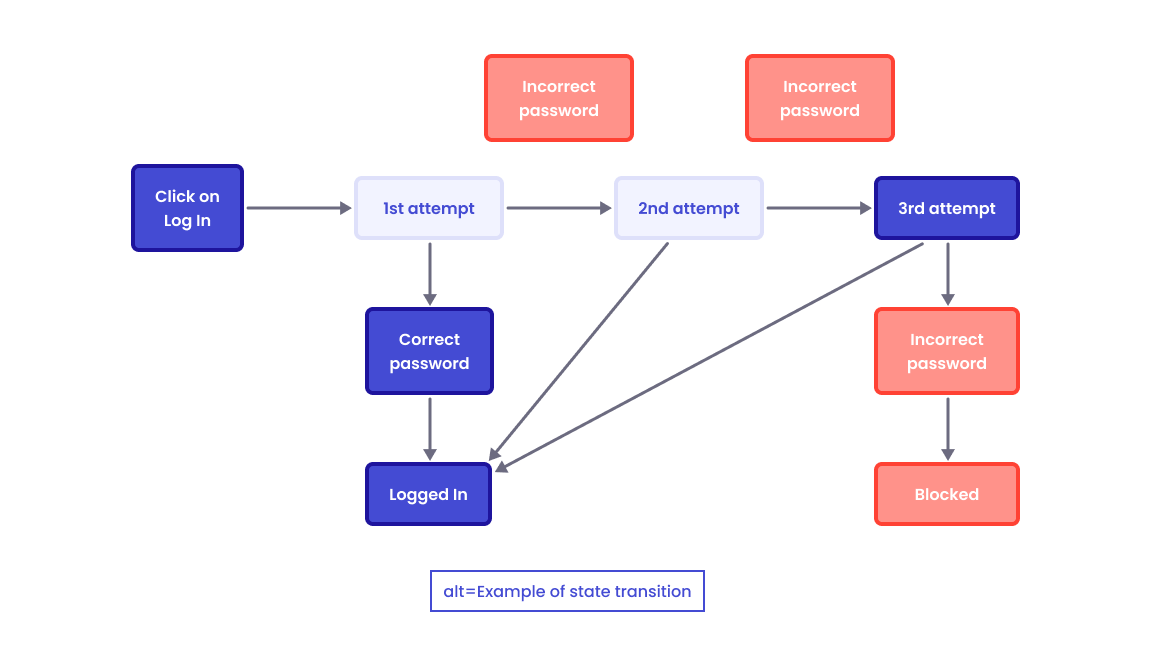
The simplest example of using this technique is testing the login page in a web or mobile app. Imagine testing a system that allows multiple attempts to enter the correct password. If the user enters an incorrect password, the system blocks access.
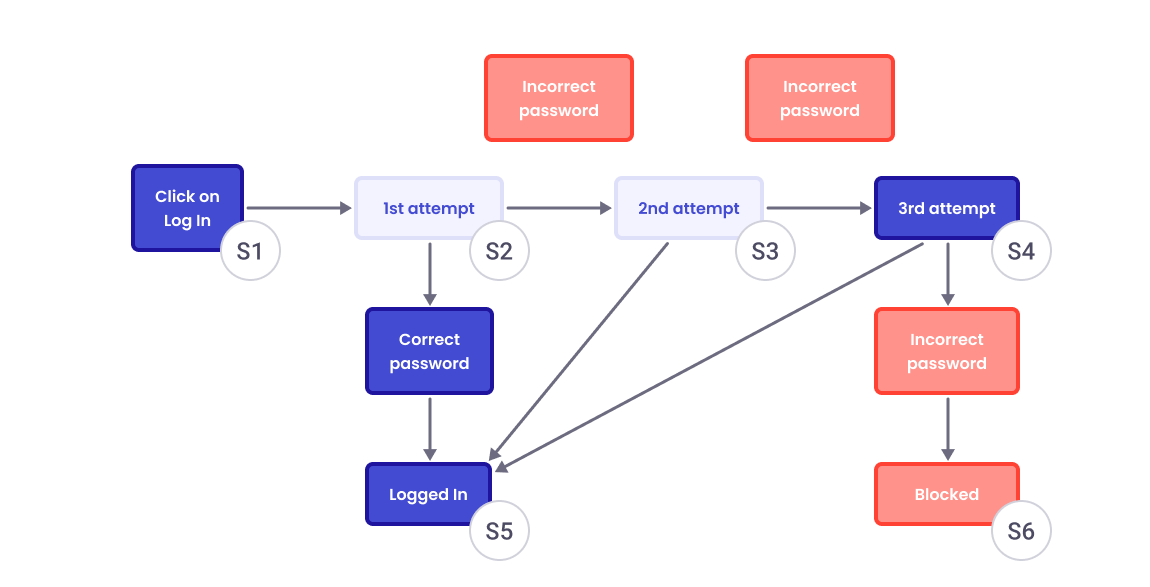
Such a diagram helps easily correlate possible inputs with expected outcomes. Having a visual representation enhances understanding and ensures the correct connection of states.
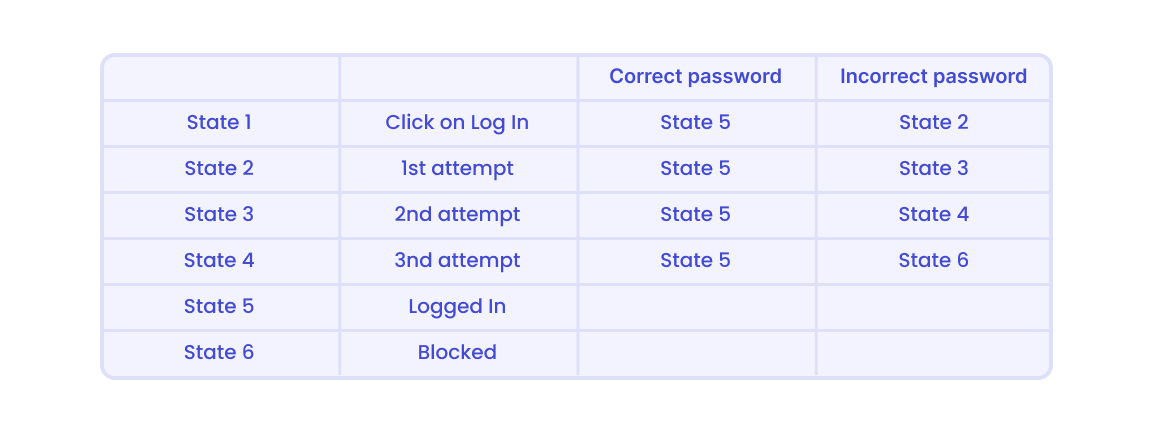
Domain Analysis Testing
This test design technique is used when testing a large set of variables simultaneously. It combines equivalence class and boundary value analysis techniques. Domain analysis testing is conducted when multiple variables need to be checked at the same time, unlike testing individual parameters using equivalence classes and boundary values.
— 🤔 Why is it important to test multiple variables at once?
→ Often there is insufficient time to create separate tests for each variable.
→ Interdependent variables need to be tested when interacting with each other.
Complex systems require special attention and effort from specialists to ensure thorough testing.
Cause-Effect Graph
The cause-effect graph is a method of test design in software testing that highlights the relationship between the result and all factors influencing it. This method is used to create dynamic test cases. For example, when entering a correct email, the system accepts it, while entering an incorrect one results in an error message. In this technique, each conditional input is assigned a cause, and the result of this input is marked as an effect.
The cause-effect graph method is based on gathering requirements and is used to determine the minimal number of test cases that cover the maximum possible test area of the software.
Key advantages include reducing test execution time and lowering testing costs.
Use Case Testing
Helps evaluate the functionality of the system by testing each use case to confirm proper operation.
A use case is a specific interaction between a user (actor) and the software (system), aimed at achieving a particular goal or task. Testers can use this method to check whether all functional requirements are met and whether the software works correctly.
Pairwise Testing
This method allows for a significant reduction in the number of tests by generating sets of test data from all possible input parameters in the system. The essence of pairwise test design is to ensure that each tested parameter’s value is combined at least once with each value of other tested parameters.
Creating the necessary data combinations is a complex task, but many tools of varying quality are available for this purpose.
This method is effective in the later stages of development or in combination with core functional tests. For example, during configuration testing, the main functionality should first be tested across all operating systems with default parameters through Smoke testing or Build Verification Tests. This greatly simplifies the detection of errors, as pairwise testing works with numerous parameters with variable values, making it challenging to locate the issue. If the build testing fails, pairwise testing should be postponed, as many tests will fail, and efforts to optimize tests will be futile.
White Box Test Design Techniques
This approach to software testing emphasizes analyzing the internal logic, structure, and code of the application. It provides testers with full access to the source code and project documentation, enabling a deep examination of internal processes, architecture, and component integration within the software.
Statement Coverage
This technique ensures that every statement in the source code is executed at least once. The method covers all possible paths, lines, and statements in the source code. It is applied for design for test to determine the number of executed statements out of the total statements in the code.
This method promotes early defect detection and ensures the verification of all possible scenarios, allowing for a higher level of test coverage and exhaustive testing.
Decision Testing | Branch Testing
Branch coverage is a code verification metric used in software testing to ensure that all possible branches in the code are executed at least once. It evaluates the effectiveness of test cases in covering various execution paths within the program.
The main focus is on testing all branches or decision points in the code. This ensures that every possible branch (true/false) at each decision point (e.g., conditional statements, loops) is verified.
Path Testing
This approach is applied to design test cases based on the analysis of the software’s control flow graph. It identifies linearly independent execution paths, optimizing the testing process. Path testing uses cyclomatic complexity to determine the number of paths, and corresponding test cases are developed for each path.
This method achieves full branch coverage of the program without requiring coverage of all possible paths in the control flow graph. McCabe’s cyclomatic complexity metric is used to identify all feasible execution paths.
Methods of path testing
- Control flow graph. Converts program code into a graph with nodes and edges.
- Decision-to-decision paths. Identifies paths between decision points in the graph.
- Linearly independent paths. These are paths that cannot be recreated by combining other paths.
✅ Benefits of path testing
- Minimizes redundant tests.
- Concentrates on program logic.
- Helps optimize test scenario development.
❌ Drawbacks of path testing
- Requires advanced programming knowledge to perform.
- The number of test scenarios increases with code complexity.
- Difficulty in creating test paths for complex programs.
- Potential for overlooking certain conditions or scenarios due to analysis errors.
Path testing is an essential tool for ensuring software quality, but its success relies on proper implementation and alignment with the program’s complexity.
alt = Path testing process
Condition Testing
The goal of this set of test design techniques is to create test cases to verify the logical conditions of a program. One of the advantages is ensuring statement coverage across all branches of the program.
Let us consider the key terminology used in conditional testing:
Simple condition is a Boolean variable or an expression that uses a relational operator 💡
→ Relational expression has the form: E1 <relational operator> E2
→ E1 and E2 are arithmetic expressions
→ The relational operator can be one of the following: <, >, =, ≤, ≥
Compound condition includes several simple conditions, Boolean operators (OR, AND, NOT), and parentheses. Conditions that do not contain relational expressions are called Boolean expressions.
Elements of conditions are:
- Boolean operator;
- Boolean variable;
- Pair of parentheses (enclosing a simple or compound condition);
- Relational operator;
- Arithmetic expression.
These elements define the types of possible errors in conditions. If a condition is incorrect, at least one of its elements will be faulty.
Accordingly, the following errors are possible:
- Incorrect Boolean operator (errors, absence, or redundancy);
- Errors in parenthesis placement;
- Issues with Boolean variables;
- Incorrect relational operator;
- Errors in arithmetic expressions.
The condition testing methodology involves verifying every condition in the program.
Condition testing methods
- Branch testing
- Domain testing
- Boolean expression testing
Thus, this is a white-box testing technique, where test conditions are determined by the results of individual elementary conditions.
Multiple Condition Testing
This method focuses on testing all possible combinations of conditions in a program. It is also referred to as Multiple Condition Decision Coverage (MCDC).
In programs with numerous conditions, it is crucial to test all their possible combinations, as certain combinations may lead to unpredictable behavior or critical errors.
👉 Multiple Condition Coverage (MCC) helps detect these scenarios, lowering the risk of software defects!
As one of the most detailed testing approaches, it instills confidence in the system’s accuracy and reliability. This is especially critical in high-risk fields such as aviation, medical devices, and nuclear energy, where even minor software errors can lead to serious consequences.
To achieve MCC, each condition is tested in both true and false states to verify all possible combinations. Furthermore, each logical decision is examined individually to ensure that all execution paths are covered at least once.
Condition Determination Testing
The ISTQB defines Condition Determination Testing as:
A white-box test technique in which test cases are designed to exercise single condition outcomes that independently affect a decision outcome.
Its goal is to ensure the accurate evaluation of each condition and the precision of the decision outcome based on the combination of these conditions.
Key condition concepts:
- Atomic condition – The smallest unit of a decision that returns either true or false.
- Decision – A point in the code where a choice is made based on one or more conditions.
- Condition coverage – Ensures that each condition is evaluated at least once as true and once as false.
- Decision coverage – Ensures that each decision is tested for both true and false outcomes.
- Condition and decision coverage (CDC) – Combines condition coverage and decision coverage.
- Modified condition and decision coverage (MCDC) – Ensures that each condition can independently affect the outcome of the decision.
By applying the Condition Determination Testing method, development teams can create more stable and reliable software products.
Loop Coverage
This technique ensures the reliability and efficiency of software, especially for parts involving iterative computations. By using this technique, it is possible to:
- Prevent infinite loops. Identify and resolve errors that could cause the program to freeze.
- Optimize performance by identifying bottlenecks in algorithms and increasing execution speed.
- Improve code quality by verifying that loops operate correctly under various conditions.
Key elements of loop testing involve:
- Evaluating loop conditions to precisely calculate the number of iterations.
- Controlling loop variables to ensure proper management.
- Testing boundary values to verify loop behavior at the edges of permissible values.
Thus, using loop coverage testing can help expand test coverage, optimize testing costs, and improve testing quality while identifying and addressing defects, errors, performance issues, and vulnerabilities in the software or system.
Experience-Based Test Design Techniques
This is not a standard approach to software testing, but rather a flexible method that relies on the intuition, skills, and prior experience of the tester. With this approach, the knowledge of developers, testers, and users is transformed into real test scenarios and valuable insights. Collaboration among all participants in the process enables the creation of effective tests that truly matter.
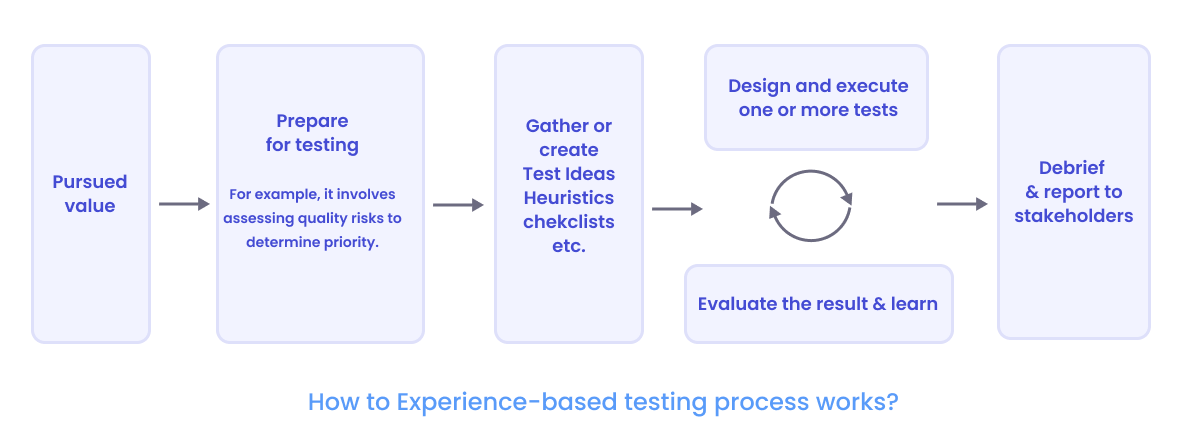
The main advantage of the technique is its ability to identify scenarios that may be overlooked by other, more rigid methodologies. While structured methods are crucial, this approach adds a creative and innovative dimension to the testing process. In today’s landscape, where quality is paramount, it could be the key to the success of your project.
Let’s explore some types of Experience-Based Testing more detail 👀
Error Guessing
This demonstrates the tester’s ability to identify areas within the application that may be prone to failures. By relying on their experience, the tester intuitively pinpoints potential weaknesses and vulnerabilities.
Exploratory Testing
This approach is based on exploration. Testers investigate the application, thoroughly analyzing its functionality using their experience and attention to detail.
Checklist-Based Testing
This approach involves creating a checklist that gathers various functionalities and usage scenarios for verification. The tester gradually checks each item to ensure that all aspects have been covered.
Therefore, experience-based testing is a valuable approach in situations that require flexibility and intuition. By utilizing the testers’ expertise, it reveals scenarios that might be missed by traditional methods. This approach addresses challenges like insufficient documentation or tight deadlines, resulting in a more thorough and efficient testing process.
Comparison of Test Design Techniques
How to choose the appropriate test case design technique? The selection is determined by several factors:
✅ The complexity of the software
✅ Project requirements
✅ Available resources
✅ Likely defect types
It is typically advisable to combine different approaches to ensure comprehensive testing. The chosen method should align with:
✅ The goals of the verification
✅ The key functionalities of the software product
✅ Potential risks
Black-box testing focuses on verifying the software’s functionality from the user’s perspective, based on requirements and specifications. On the other hand, white-box testing focuses on analyzing the internal structure of the program, including the code, architecture, and integration. Experience-based testing is not a traditional method for verifying software – it is an adaptive approach that relies on intuition, skills, and the tester’s previous experience.
Combining all methods ensures comprehensive software quality control, covering both functional and structural aspects. Each approach plays its unique role in identifying and addressing issues at different stages of development. To achieve the best results, it is crucial to adapt testing methods according to your project’s requirements.
Challenges and Best Practices in Test Design
- Complexity. Designing test cases for complex systems with numerous dependencies can be challenging.
- Changing Requirements. Frequent changes in requirements may necessitate constant updates to test cases.
- Time Constraints. Balancing the level of detail with time limitations requires prioritization and efficiency.
To overcome these challenges, it is essential to adhere to the following principles to improve productivity and efficiency.
Best practices in test design
- Clarity and precision. Test cases must be clear and unambiguous.
- Prioritization of critical paths. Focus first on high-risk areas and critical functionalities.
- Reusing test cases. Where possible, reuse test cases for similar functionalities.
- Implementing test automation. Useful for repetitive and large-scale test cases, saving time and improving efficiency.
- Continuous improvement. Regularly review and improve test cases based on test execution results and feedback.
Effective test design ensures that the software testing process is thorough, efficient, and aligned with the project’s quality goals. By planning and executing test case design techniques, defects can be detected early, product quality can be improved, and client satisfaction can be enhanced.
A Few Practical Examples & Use Cases:
— How It Can Cut Spending and Optimize a Testing Budget 👀
Testing with one user early in the project is better than testing with 50 near the end.
Steve Krug,
a UX professional
Fixing issues early in the development process is much cheaper. For instance, if issues are overlooked during the design phase, their impact can multiply as the project progresses. During development, these errors may become embedded in the program’s core structure, potentially disrupting its functionality. Making major changes to the software architecture after testing, or particularly after the product launch, demands considerable resources and financial investment. This could also result in a loss of user trust due to malfunctioning software.
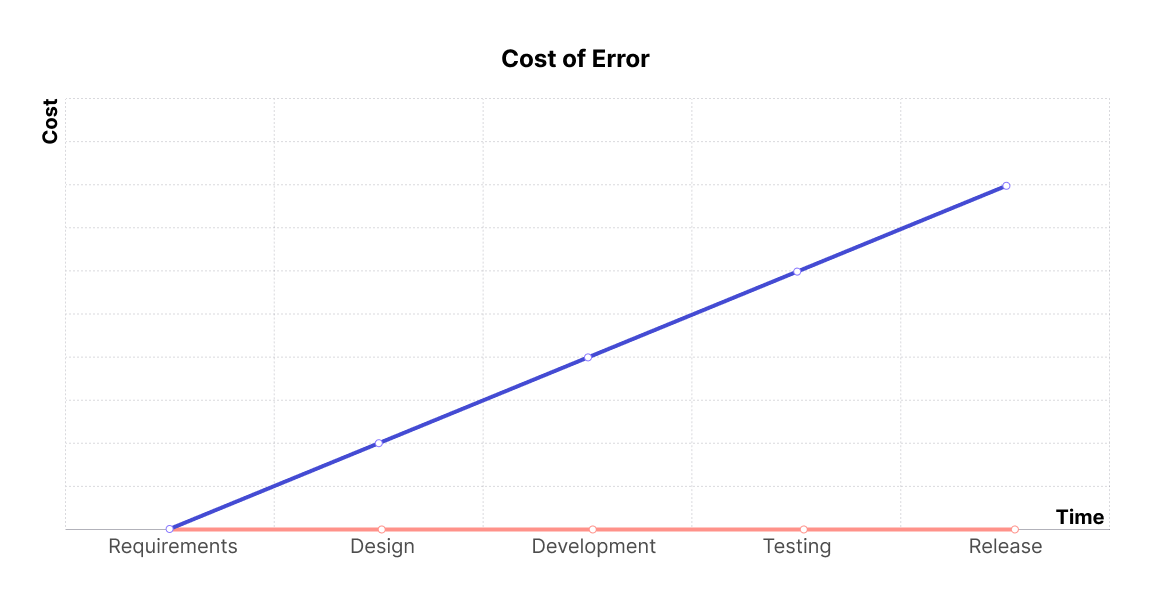
That’s why it’s important to test each component of the program during its development. In such cases, iterative test case design techniques, typical of agile approaches, demonstrate their effectiveness.
Tools Make Our Test Design Easier
Open-source frameworks are leading among the most popular testing tools. Among them, Selenium, Cypress, JUnit, TestNG, Appium, Cucumber, and Pytest have gained the most popularity and are used for various types of testing.
Test management systems or tools are specialized software that helps quality teams organize, coordinate, and control testing processes. These platforms can integrate with automated testing tools, CI\CD systems, bug-tracking tools, and other solutions.
The market offers a wide variety of test management tools for different budgets and tasks. Here are a few popular options:
- Testomat.io – a tool for full test management with just a few clicks, significantly speeding up the development cycle. It offers “all-in-one” automation.
- Zephyr – used for test management, focused on Agile and DevOps.
- SpiraTest – a universal test management tool that allows planning processes, tracking defects, and managing requirements.
- TestRail – a comprehensive solution with numerous integration capabilities with automation tools and bug-tracking systems. It has powerful reporting features with adaptive dashboards.
- Kualitee – a tool for managing test cases, defects, and reporting. It integrates with various testing systems, including mobile ones.
Depending on the chosen tool, test management systems can significantly ease test design, increase efficiency, promote process organization, improve communication, and provide a complete overview of progress.
Summary
Overall, test creation plays a crucial role in the software development process. This is where theoretical knowledge about testing methods turns into practical, effective checks. By carefully applying proven test design techniques, testers ensure that each release meets the highest quality standards, guaranteeing users a reliable and functional product. Thus, testing is not just about finding bugs, but also confirming the software’s ability to work flawlessly under real conditions, making this stage critical to the success of any project.
